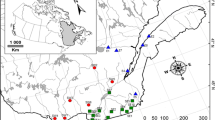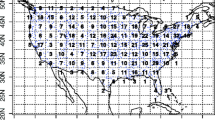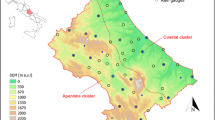Abstract
Long-term variations of monthly average maximum and minimum temperature (TMAX and TMIN) and precipitation records in southern Brazil are investigated for the 1913–2006 period. These variations are carefully analyzed for seasonal and annual indices, taken as regional averages. For this purpose, the serial correlation and trend of the indices are investigated using the run and Mann–Kendall tests. The significant trends are obtained from linear least-square fits. The annual and seasonal TMIN indices show significant warming trends with magnitudes (1.7°C per 100 years for annual index) comparable to those reported by the Intergovernmental Panel on Climate Change, but lower than those found for the southern Brazil in another previous work. Regarding the two other variables, the indices show significant trends only for summer, being a cooling trend of 0.6°C per 100 years for the TMAX and an increasing trend of 93 mm per 100 years over an average summer precipitation of 367 mm. Concerning the decadal analysis, the 1920s present the lowest annual, autumn, and spring TMIN and the 1990s, the highest ones. The 1970s is the decade with the lowest summer TMAX, and the 1940s the decade with the highest one. The driest decade is the 1940s and the wettest, the 1980s.




Similar content being viewed by others
References
Easterling DR, Horton BH, Jones PD, Peterson TC, Karl TR, Parker DE, Salinger MJ, Razuvayev V, Plummer N, Jamason P, Folland CK (1997) Maximum and minimum temperature trends for the globe. Science 277:364–367
Hamed KH, Rao AR (1998) A modified Mann-Kendall trend test for autocorrelated data. J Hydrology 204:182–196
Haylock MR, Peterson T, Alves LM, Ambrizzi T, Anunciação YMT, Baez J, Barros VR, Berlato MA, Bidegain M, Coronel G, Corradi V, Garcia VJ, Grimm AM, Karoly D, Marengo JA, Marino MB, Moncunill DF, Nechet D, Quintana-Gomes J, Rebello E, Rusticucci M, Santos JL, Trebejo I, Vincent L (2006) Trends in total and extreme South America rainfall in 1960–2000 and links with sea-surface temperatures. J Climate 19:1490–1512
Huth R, Pokorná L (2004) Parametric versus non-parametric estimates of climatic trends. Theor Appl Climatol 77:107–112
IPCC (2001) Climate change: impacts, adaptation, and vulnerability. In: Mc Carthy JJ, Canziani OF, Leary NA, Dokken, DJ, White, KS (eds). Cambridge University Press, Cambridge, p 1032
IPCC (2007) Climate change 2007: synthesis report. IPCC Plenary XXVII, Valencia, p 73
Karl TR, Jones PD, Knight RW, Kukla G, Plummer N, Razuvayev V, Gallo KP, Lindseay J, Charlson RJ, Peterson TC (1993) Asymmetric trends of daily maximum and minimum temperature. Bull Amer Meteor Soc 74:1007–1023
Lough JM (1995) Temperature variations in a tropical-subtropical environment: Queensland, Australia, 1910–1987. Inter J Climatol 15:77–95
Mantua NJ, Hare SR, Zhang Y, Wallace JM, Francis RC (1997) A Pacific interdecadal climate oscillation with impacts on salmon production. Bull Amer Meteor Soc 78:1069–1079
Marengo JA, Camargo CG (2008) Surface air temperature trends in southern Brazil for 1960–2002. Inter J Climatol 28:893–904
Nunez MN, Ciapessoni HH, Rolla A, Kalnay E, Cai M (2006) Estimation of the impact of land-surface forcings on temperature trends in Argentina. Proceedings of the VIII International Conference on the Southern Hemisphere Meteorology and Oceanography. Foz do Iguaçu, Brazil, pp 919–925
Quintana-Gomes RA (1999) Trends of maximum and minimum temperature in northern South America. J Climate 12:2104–2112
Rusticucci M, Barrucand M (2004) Observed trends and changes in temperature extremes over Argentina. J Climate 17:4099–4107
Rusticucci M, Tencer B (2006) Changes in extreme temperatures return periods over Argentina. Proceedings of the VIII International Conference on the Southern Hemisphere Meteorology and Oceanography, Foz do Iguaçu, pp 391–400
Sneyers R (1975) Sur l'analyse statistique des series d'observations. Organisation Météorologique Mondial, Genève, p 192 (OMM Note Technique, 143)
Vincent LA, Petterson TC, Barros VR, Marino MB, Rusticucci M, Carrasco G, Ramirez E, Alves LM, Ambrizzi T, Berlato MA, Grimm AM, Marengo JA, Molion LC, Moncunill DF, Rebello E, Anunciação YMT, Quintana-Gomes J, Santos JL, Baez J, Coronel G, Garcia J, Trebejo I, Bidegain M, Haylock MR, Karoly D (2005) Observed trends in indices of daily temperature extremes in South America 1960–2000. J Climate 18:5011–5023
Von Storch VH (1995) Misuses of statistical analysis in climate research. In: von Storch HV, Navarra A (eds) Analysis of climate variability: applications of statistical techniques. Springer-Verlag, Berlin, pp 11–26
Acknowledgements
The second author was partially supported by the Conselho Nacional de Desenvolvimento Científico e Tecnológico of Brazil. Thanks are due to two anonymous reviewers for their useful comments on earlier version of this work.
Author information
Authors and Affiliations
Corresponding author
Rights and permissions
About this article
Cite this article
Sansigolo, C.A., Kayano, M.T. Trends of seasonal maximum and minimum temperatures and precipitation in Southern Brazil for the 1913–2006 period. Theor Appl Climatol 101, 209–216 (2010). https://doi.org/10.1007/s00704-010-0270-2
Received:
Accepted:
Published:
Issue Date:
DOI: https://doi.org/10.1007/s00704-010-0270-2




